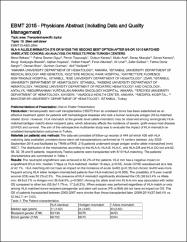HLA-A allele mismatch (7/8 or 9/10) is the second best option after 8/8 or 10/10 matched unrelated donors: An analysis on results from Turkish centers

Göster/
Erişim
info:eu-repo/semantics/openAccessTarih
2015Yazar
Beksaç, MeralSavran Oğuz, Fatma
Topçuoğlu, Pervin
Karasu, Gülsun
Arat, Mutlu
Aksoylar, Serap
Kansoy, Savaş
Kalayoğlu Beşışık, Sevgi
Küpesiz, Alphan
Hazar, Volkan
Altuntaş, Fevzi
Ünal, Ali
Gülbaş, Zafer
Sargın, Fatma Deniz
İlhan, Osman
Gürman, Günhan
Yeşilipek, Akif
Üst veri
Tüm öğe kaydını gösterKünye
Beksaç, M., Savran Oğuz, F., Topçuoğlu, P., Karasu, G., Arat, M., Aksoylar, S. ... Yeşilipek, A. (2015). HLA-A allele mismatch (7/8 or 9/10) is the second best option after 8/8 or 10/10 matched unrelated donors: An analysis on results from Turkish centers. 41st Annual Meeting of the European-Society-for-Blood-and-Marrow-Transplantation içinde (S361-S362. ss.). Istanbul, Turkey, March 22-25, 2015.Özet
Introduction: Hematopoietic stem cell transplantation (HSCT) from an unrelated donor has been established as an effective treatment option for patients with hematological diseases who lack a human leukocyte antigen (HLA)-matched related donor. However, HLA mismatch at the genetic level (allele mismatch) may be observed among serologically HLAmatched (antigen match) donor-recipient pairs, which adversely affects the incidence of severe graft-versus-host disease (GVHD) and survival. The aim of this retrospective multicenter study was to evaluate the impact of HLA mismatch on unrelated transplantation outcomes in Turkey. Materials (or patients) and methods: The data set consisted of follow-up records of 444 (of which 436 with HLA matching data available) unrelated-donor stem cell transplantations performed at 14 centers between July 2002- September 2014 and facilitated by TRAN orTRIS .215 patients underwent single antigen and/or allele-mismatched (mm) HSCT. The distribution of the mismatches according to the HLA-A, HLA-B, HLA-C, and HLA-DR and HLA-DQ loci are:82, 58, 32, 35 and 9 patients, respectively.Twelve patients were transplanted with 8/10 HLA matching. The patients’ characteristics are summarized in Table 1. Results: The neutrophil engraftment was achieved in 82.2% of the patients. HLA mm has a negative impact on engraftment (HLA mm: median 17days vs HLA-matched: median 16 days, p=0.03). Acute GVHD wasobserved at a rate of 42.1%. HLA matching did not have an impact on the incidence of acute GvHD (p=0.35) but chronic GvHD was more frequent among HLA allele /antigen mismatched patients than HLA-matched (p=0.008). The possibility of 5-year overall survival (OS) was 50.2%±2.5%. The presence of HLA mismatch significantly shortened the OS (58.9±3.4% vs Allele mm: 49.8±5.7% vs Antigen mm 36.0±4.9%, p<0.0001).Among the allele level mm HLA-A mm was associated with better OS compared to other loci (55.9±11.7%vs. 17.2±8.2%). When analysis was performed regardless of HLA match or only among HLA matched donor-recipient-pairsgender and stem cell source (PB vs BM) did not have an impact on OS. The OS of patients transplanted between 2002-2007 were shorter than those transplanted later (2008-2014)(37.9±6.4% vs. 52.9±2.7; p= 0.02).
WoS Q Kategorisi
Q1Kaynak
41st Annual Meeting of the European-Society-for-Blood-and-Marrow-TransplantationCilt
50Sayı
Supplement: 1Koleksiyonlar
- Bildiri Koleksiyonu [516]
- WoS İndeksli Yayınlar Koleksiyonu [6631]

















